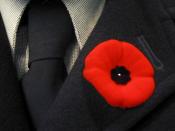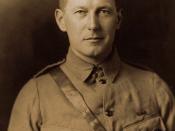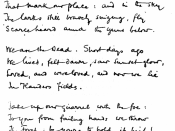During World War One, poet John McCrae wrote many pieces of literature. He published many short stories but was most famous for his poem In Flanders Fields. This poem uses many instances of symbolism and imagery to convey the main idea to the reader.
In the first line it says "In Flanders Fields the poppies blow". The poppy is known as a symbol of sleep. The last line "We shall not sleep, though poppies grow / In Flanders Fields" point to this fact. Some kinds of poppies can be used to derive opium, from which morphine can be made. Morphine is one of the strongest painkillers and was often used to put a wounded soldier to sleep. Sometimes medical doctors used it in a higher dose to put the incurably wounded out of their misery. Poppies were also the only plant that grew in the western front during the war, and during that time poppies were constantly being blown into the author's face, which gave him reason enough and the inspiration to include them in the poem.
Other symbols in this poem include the larks, sited in lines four and five. The idea McCrae conveys in this stanza is the fragility of human life "The larks, still bravely singing, fly / Scarce heard amid the guns below." The lark (bird) is known for its careless free spirit that symbolizes the oblivious people living in areas free from war. Meaning while life is being snatched away from the soldiers, people like us are carrying on with our carefree lives oblivious to the horrors of the battlefield. The last stanza (see poem) has the most important piece of symbolism in the poem . . . the torch. The torch represents the war itself, and if no one were to...


